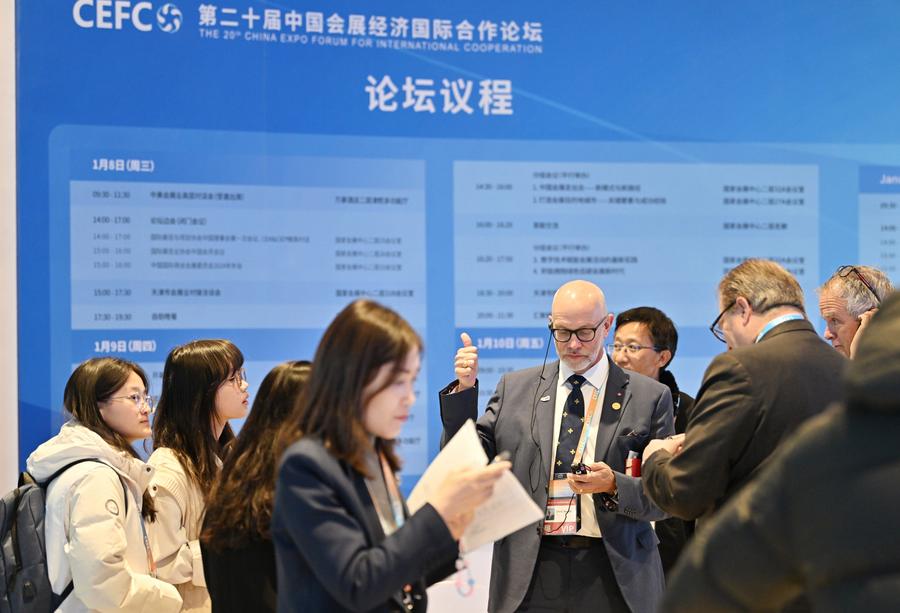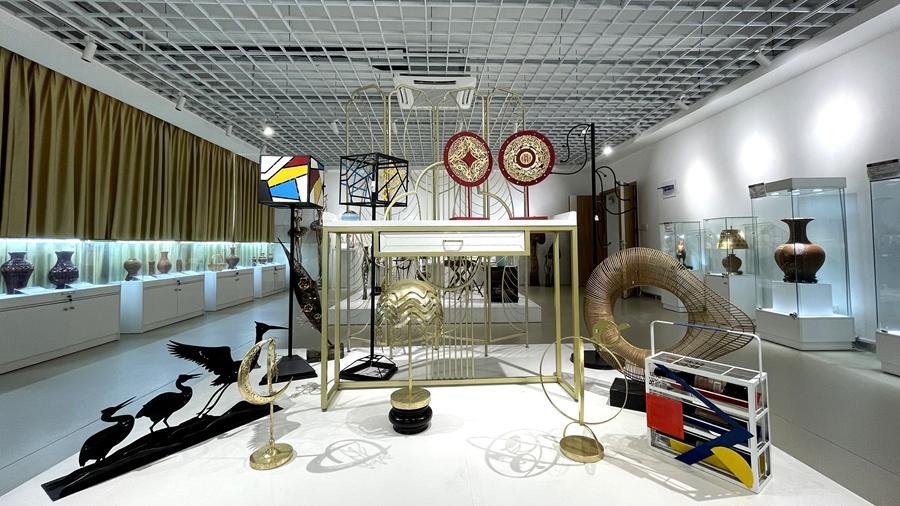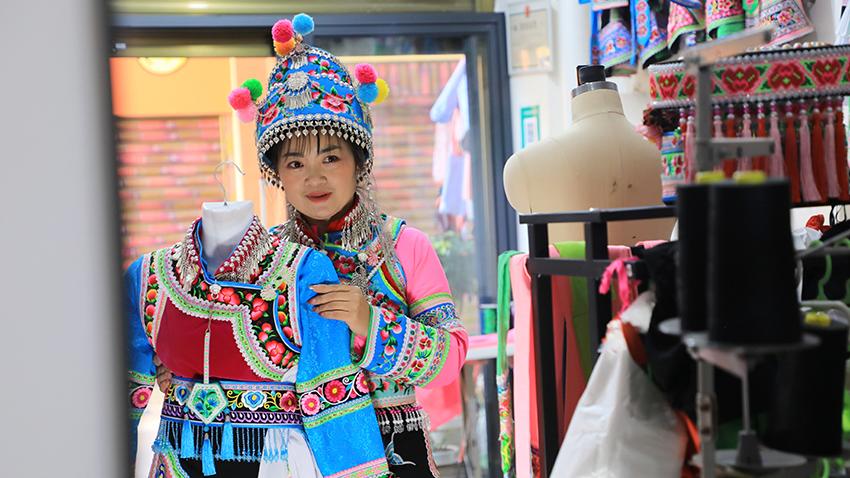China's exhibition industry expands global reach

A participant tests his interpretation device during the 20th China Expo Forum for International Cooperation in Tianjin, north China, Jan. 9, 2025. (Xinhua/Li Ran)
TIANJIN, Jan. 12 (Xinhua) -- Every year, the Shanghai New International Expo Center (SNIEC) hosts over 100 exhibitions, attracting more than 7 million visitors, Michael Kruppe, the center's general manager, proudly highlights its achievements since entering the Chinese market 23 years ago.
A Sino-German joint venture, SNIEC is a testament to the evolution of China's exhibition industry, which has become one of the most significant and dynamic sectors globally.
According to Kruppe, China's exhibition industry has become an indispensable global connector. He emphasizes that China is one of the most promising markets worldwide, and many international exhibition companies stand to benefit from the rapid growth of the sector.
"I'm happy to witness the market's fast development, not only in quantity but also in quality, in terms of the growing events, exhibitions and conventions we have," said Kruppe, who hails from Germany.
During the 20th China Expo Forum for International Cooperation (CEFCO), a key annual event in the global exhibition industry, held in Tianjin from Jan. 8 to 10, Kruppe signed several new agreements with international associations and industry players.
"I think that is a fantastic start for at least another 10 or 20 years of growth in the industry," he said.
Loy Joon How, vice chairman of the Thai Exhibition Association who attended the CEFCO, also expressed strong confidence in China's market. He expressed his desire to connect with new Chinese industry colleagues, gain insights into the latest market trends in China, and explore potential collaboration opportunities.
Since its launch in 2005, the expo has helped China's exhibition industry build a stronger international network. The event has been instrumental in forming new partnerships and encouraging well-known global exhibition companies to set up operations in China.
Speaking at this year's CEFCO, Miao Ruiqing, project manager Asia of Advanced Business Events SAS, highlighted the company's nearly 20 years of involvement in the Chinese market, where it frequently organizes aerospace exhibitions in cities such as Tianjin and Guangzhou.
Miao pointed to the International Helicopter Expo in Tianjin as a prime example, noting that the proportion of international exhibitors traveling from abroad has significantly increased, now making up 60 percent of the total. This increase underscores China's growing significance as a key global hub for industry events.
"China boasts world-class exhibition infrastructure, a solid technical foundation and a favorable business environment. The Chinese government's strong support for the industry has made it an increasingly attractive destination for international exhibitors," Miao said.
In recent years, the Chinese government has regarded the exhibition industry as a key driver of economic growth, supporting domestic enterprises in exploring international markets while also welcoming global companies to benefit from China's development.
Major exhibitions across the country, including the China International Import Expo, China International Supply Chain Expo and China International Fair for Trade in Services, have evolved into key platforms for global communication and cooperation, with an increasing participation of international exhibitors.
According to the China Council for the Promotion of International Trade (CCPIT), as of December 2024, a total of 265 exhibition projects in China have been certified by UFI, the Global Association of the Exhibition Industry. This certification, which recognizes the quality and scale of an exhibition, marks an increase of over 20 percent compared to the previous year.
Easier travel for foreign nationals to China has further internationalized the exhibition industry, making it more accessible and appealing to global participants. A range of visa-free policies and facilitation measures for overseas attendees have effectively unleashed the potential of China's exhibition sector.
Driven by multiple favorable factors, China's exhibition industry experienced steady growth in 2024, hosting 3,844 economic and trade events. According to a CCPIT report, the total exhibition space grew by 10.1 percent year on year, reaching 155 million square meters.
The growth of the country's exhibition industry has also driven many Chinese enterprises to reach out globally, helping create a more expansive and integrated global exhibition ecosystem.
In 2024, the CCPIT approved and executed 1,166 outbound exhibition projects, involving 60 countries and regions, with a total of 50,100 participating enterprises.
Tomasz Szypu a, president of Ptak Warsaw Expo, one of Poland's largest exhibition venues, attended the CEFCO for the sixth time this year. He noted that in 2024, his venue hosted around 100 commercial exhibitions across various sectors such as energy, construction, healthcare and food, attracting nearly 1,000 Chinese exhibitors. Looking ahead to 2025, Szypu a estimated that the number of Chinese exhibitors would increase to about 2,000.
Against a backdrop of rising anti-globalization, protectionism and unilateralism, industry insiders believe that the global exhibition sector has the potential to promote cooperation and help address the challenges posed by geopolitical tensions.
"Open trade is always the best situation for the whole world. Otherwise, it's not good for anybody," Kruppe said, adding that China is actively promoting global communication and cooperation.
"The exhibition industry plays a vital role in bridging production and consumption, supply and demand, and domestic and international markets. It connects enterprises, markets and resources across the globe, serving as an irreplaceable force in driving economic and social growth. It also fosters international trade and economic cooperation," said Ren Hongbin, chairman of CCPIT.
Photos
 Anxi in SE China's Fujian develops rattan iron crafts into industrial chain worth over 10 bln yuan
Anxi in SE China's Fujian develops rattan iron crafts into industrial chain worth over 10 bln yuan Scenery of snow-covered tea plantations in Zunyi, China's Guizhou
Scenery of snow-covered tea plantations in Zunyi, China's Guizhou Woman revitalizes intangible cultural heritage items with a stylish twist
Woman revitalizes intangible cultural heritage items with a stylish twist Cherry blossoms and birds create a winter spectacle in SW China's Yunnan
Cherry blossoms and birds create a winter spectacle in SW China's Yunnan
Related Stories
- China sees surge in industrial, technological expos in 2024: report
- Chinese companies showcase technology innovations at CES 2025
- China, Nigeria forge stronger economic ties at Abuja trade expo
- Chinese companies under spotlight at Malaysian smart technology expo
- Light of Internet Expo kicks off during 2024 World Internet Conference Wuzhen Summit
Copyright © 2025 People's Daily Online. All Rights Reserved.





